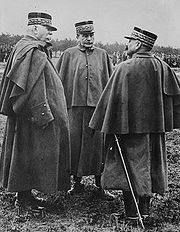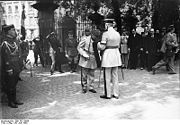
Adolphe Guillaumat
Encyclopedia


Bourgneuf, Charente-Maritime
Bourgneuf is a commune in the Charente-Maritime in the department in the Poitou-Charentes region in southwestern France.General Adolphe Guillaumat was born in Bourgneuf.-Population:-External links:* * *Map and aerial photos:...
, January 4, 1863- Nantes
Nantes
Nantes is a city in western France, located on the Loire River, from the Atlantic coast. The city is the 6th largest in France, while its metropolitan area ranks 8th with over 800,000 inhabitants....
, May 18, 1940) was a French Army
French Army
The French Army, officially the Armée de Terre , is the land-based and largest component of the French Armed Forces.As of 2010, the army employs 123,100 regulars, 18,350 part-time reservists and 7,700 Legionnaires. All soldiers are professionals, following the suspension of conscription, voted in...
general
General
A general officer is an officer of high military rank, usually in the army, and in some nations, the air force. The term is widely used by many nations of the world, and when a country uses a different term, there is an equivalent title given....
during World War I
World War I
World War I , which was predominantly called the World War or the Great War from its occurrence until 1939, and the First World War or World War I thereafter, was a major war centred in Europe that began on 28 July 1914 and lasted until 11 November 1918...
.
Early years
Adolphe Guillaumat graduated first from his class of 1884 at the Saint-CyrÉcole Spéciale Militaire de Saint-Cyr
The École Spéciale Militaire de Saint-Cyr is the foremost French military academy. Its official name is . It is often referred to as Saint-Cyr . Its motto is "Ils s'instruisent pour vaincre": literally "They study to vanquish" or "Training for victory"...
military academy.
Career
After a career partly spent in the French Colonies (AlgeriaAlgeria
Algeria , officially the People's Democratic Republic of Algeria , also formally referred to as the Democratic and Popular Republic of Algeria, is a country in the Maghreb region of Northwest Africa with Algiers as its capital.In terms of land area, it is the largest country in Africa and the Arab...
, Tunisia
Tunisia
Tunisia , officially the Tunisian RepublicThe long name of Tunisia in other languages used in the country is: , is the northernmost country in Africa. It is a Maghreb country and is bordered by Algeria to the west, Libya to the southeast, and the Mediterranean Sea to the north and east. Its area...
, Tonkin
Tonkin
Tonkin , also spelled Tongkin, Tonquin or Tongking, is the northernmost part of Vietnam, south of China's Yunnan and Guangxi Provinces, east of northern Laos, and west of the Gulf of Tonkin. Locally, it is known as Bắc Kỳ, meaning "Northern Region"...
, China
China
Chinese civilization may refer to:* China for more general discussion of the country.* Chinese culture* Greater China, the transnational community of ethnic Chinese.* History of China* Sinosphere, the area historically affected by Chinese culture...
), he was appointed Director of Infantry, with the rank of Brigadier General
Brigadier General
Brigadier general is a senior rank in the armed forces. It is the lowest ranking general officer in some countries, usually sitting between the ranks of colonel and major general. When appointed to a field command, a brigadier general is typically in command of a brigade consisting of around 4,000...
in October 1913.
At the start of World War I
World War I
World War I , which was predominantly called the World War or the Great War from its occurrence until 1939, and the First World War or World War I thereafter, was a major war centred in Europe that began on 28 July 1914 and lasted until 11 November 1918...
, he was chief of Minister of War
Minister of Defence (France)
The Minister of Defense and Veterans Affairs is the French government cabinet member charged with running the military of France....
Adolphe Messimy's military cabinet. When the latter left office, Guillaumat was appointed as the head of the 33rd Infantry Division on August 30, 1914 and then of the 4th Infantry Division on December 9, 1914. He led the 1st Army Corps
I Corps (France)
The I Corps was first formed before World War I. During World War II it fought in the Campaign for France in 1940, on the Mediterranean islands of Corsica and Elba in 1943 - 1944, and in the campaigns to liberate France in 1944 and invade Germany in 1945....
from February 25, 1915, and on December 15, 1916, he replaced Robert Nivelle
Robert Nivelle
Robert Georges Nivelle was a French artillery officer who served in the Boxer Rebellion, and the First World War. In May 1916, he was given command of the French Third Army in the Battle of Verdun, leading counter-offensives that rolled back the German forces in late 1916...
as commander of the Second Army
Second Army (France)
The Second Army was a Field army of the French Army during World War I and World War II. The Army became famous for fighting the Battle of Verdun in 1916 under Philippe Pétain.-World War I:*General de Curières de Castelnau...
, when the latter was made commander-in-chief of the French Army
French Army
The French Army, officially the Armée de Terre , is the land-based and largest component of the French Armed Forces.As of 2010, the army employs 123,100 regulars, 18,350 part-time reservists and 7,700 Legionnaires. All soldiers are professionals, following the suspension of conscription, voted in...
.
Guillaumat was sent to replace general Sarrail
Maurice Sarrail
Maurice-Paul-Emmanuel Sarrail was a French general of the First World War. Sarrail endeared himself to the political elite of the Third Republic through his openly socialist views, all the more conspicuous in contrast to the Catholics, conservatives and monarchists who dominated the French Army...
as commander of the French Forces in Salonika in December, 1917. He laid the plans later executed by his replacement, general Franchet d’Esperey, and rebuilt the relations with France's allies somewhat damaged by his predecessor. Guillaumat was recalled to Paris
Paris
Paris is the capital and largest city in France, situated on the river Seine, in northern France, at the heart of the Île-de-France region...
on 17 June 1918 and replaced with Franchet d’Esperey.
There, he replaced Auguste Dubail
Auguste Dubail
Auguste Yvon Edmond Dubail was a French Army general. He commanded the First Army and Army Group East during World War I.-Biography:...
as military governor of Paris. After the success of the Second Battle of the Marne
Second Battle of the Marne
The Second Battle of the Marne , or Battle of Reims was the last major German Spring Offensive on the Western Front during the First World War. The German attack failed when an Allied counterattack led by France overwhelmed the Germans, inflicting severe casualties...
, he was appointed to the Supreme War Council. He then returned to active command as commander of the Fifth Army, which he led through the Ardennes
Ardennes
The Ardennes is a region of extensive forests, rolling hills and ridges formed within the Givetian Ardennes mountain range, primarily in Belgium and Luxembourg, but stretching into France , and geologically into the Eifel...
at the end of the war.
After the war, Guillaumat served as Commander in chief of Allied occupation forces in Germany, then was a Minister of War
Minister of Defence (France)
The Minister of Defense and Veterans Affairs is the French government cabinet member charged with running the military of France....
in a short-lived June 23-July 19, 1926) government led by Aristide Briand
Aristide Briand
Aristide Briand was a French statesman who served eleven terms as Prime Minister of France during the French Third Republic and received the 1926 Nobel Peace Prize.- Early life :...
, who had been his 1-year elder at the Nantes
Nantes
Nantes is a city in western France, located on the Loire River, from the Atlantic coast. The city is the 6th largest in France, while its metropolitan area ranks 8th with over 800,000 inhabitants....
Lycée. (His son Pierre Guillaumat
Pierre Guillaumat
Pierre Guillaumat was a Minister of National Education and Minister of the Armies under French President Charles De Gaulle and founder of the Elf Aquitaine oil company in 1967. He was the son of French general Adolphe Guillaumat....
served as a Minister of the Armies
Minister of Defence (France)
The Minister of Defense and Veterans Affairs is the French government cabinet member charged with running the military of France....
of General De Gaulle
Charles de Gaulle
Charles André Joseph Marie de Gaulle was a French general and statesman who led the Free French Forces during World War II. He later founded the French Fifth Republic in 1958 and served as its first President from 1959 to 1969....
after the latter's return to power from June 1, 1958 to February 5, 1960).
Personal life
Adolphe Guillaumat married Louise Bibent from ToulouseToulouse
Toulouse is a city in the Haute-Garonne department in southwestern FranceIt lies on the banks of the River Garonne, 590 km away from Paris and half-way between the Atlantic Ocean and the Mediterranean Sea...
on July 17, 1906 and had two sons: Louis, who became an Ophthalmologist, and Pierre
Pierre Guillaumat
Pierre Guillaumat was a Minister of National Education and Minister of the Armies under French President Charles De Gaulle and founder of the Elf Aquitaine oil company in 1967. He was the son of French general Adolphe Guillaumat....
, who became a Civil servant.
General Guillaumat was a practising Catholic
Catholic
The word catholic comes from the Greek phrase , meaning "on the whole," "according to the whole" or "in general", and is a combination of the Greek words meaning "about" and meaning "whole"...
and an admirer of Frédéric Bastiat
Frédéric Bastiat
Claude Frédéric Bastiat was a French classical liberal theorist, political economist, and member of the French assembly. He was notable for developing the important economic concept of opportunity cost.-Biography:...
.

